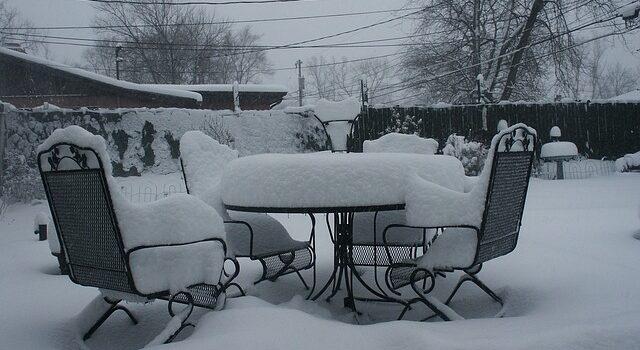
There are many potential health impacts from exposure to mouldy and wet conditions. Moulds can irritate certain people. They may experience symptoms from mould exposure such as runny nose, wheezing, red or itchy eyes, or skin. During the winter, everyone prefers to keep their patio furniture free of mould and in good condition, ready for the next summer.
How to prepare outdoor furniture for winter storage
Winterising the furnishings is the phrase used most often. Patio furniture is made to be used outside. However, if you don’t take the necessary precautions, the fall and winter weather can harm your furnishings. If you don’t want to keep your patio furniture outside, there are a few options for outdoor furniture storage. The first step, though, is to clean and protect your furniture with sealants before putting it away or covering it for the winter. Even while it could take some time, you won’t regret it in the spring. Additionally, you’ll save money by covering your patio furniture for the winter. Patio furniture sets are expensive, and even one severe blizzard can permanently ruin one if left exposed.
Wooden furniture
The biggest threat to wood furniture is moisture. Moisture will seep into ridges and gaps if not sealed. The humidity will freeze when the temperature drops, causing wood to split. Furniture oil and protective coatings can stop this.
Your furniture should be cleaned entirely before any sealants are applied. To avoid scratching the wood, gently scrub in the direction of the grain using a soft brush or cloth. Add a few drops of an oil-based soap to some warm water.
To prevent the surface from cracking or becoming brittle, apply furniture oil. This is crucial if you live somewhere with long, chilly winters. To stop moisture from penetrating the wood, use a sealer. This water will freeze in the north and could cause your furniture to fracture. It might result in mould and mildew in the South. Sealants will also shield against fungi and parasites to prolong the lifespan of your furniture.
Teak furniture
Using a sealant is one method of winterising teak furniture. As the name suggests, a teak sealer coats the wood with a thin, waterproof coating. This successfully stops the damaging effects of the freeze-thaw-freeze cycle by preventing moisture from entering those microscopic crevices in the first place.
Another excellent approach to winterproofing your teak outdoor furniture is with a quality, sturdy cover. In addition, covers offer actual protection from flying debris like branches, ice pieces, acorn showers, and other things that can damage your furniture when blown by blizzard winds.
You could believe that bringing your teak furniture inside is the best method to take care of it. It’s okay as long as you have enough space and a sturdy back. However, there are a few issues with this strategy. If you move the furniture into a hot location inside your home, temperature change may be an issue, so patio furniture storage inside your house may not be the best idea.
Aluminium furniture
Some of the most resilient outdoor furniture is made of aluminium. It won’t be damaged by cold or rain so it may be left outside in almost any weather. The only type of weather where you should pay attention to aluminium furniture is when it’s very windy. This furniture is prone to be blown around because it is lightweight. But its small weight also makes moving it inside an easy job.
Metal furniture
Outside, metal will rust due to rain and snow, destroying the furniture’s structural integrity. Before keeping metal furniture outside, use a rust-neutralizing primer to treat any potential rust. Any fading can be fixed by spray painting the metal with a coat that matches the metal’s original colour. Your metal furniture will be protected to the fullest extent possible in even the worst circumstances with automotive wax.
Cushions and fabrics
The majority of fabrics, including those used in cushions, should be carried indoors or stored. Fabrics are prone to developing mould and mildew, so it’s crucial to dry them properly before putting them away for the winter. If the cushions are removable, remove them and wash them in the cleaning solution suggested to get rid of the mildew. Dry them, then loosely stack them somewhere clean and dry. You could easily locate a location to store materials and pillows. Don’t place cushions under covers if you’ve already decided to use them. Instead, bring them inside.
Disassemble or cover
Ample space and balanced weight distribution are necessary for adequately storing outdoor furniture. To make storage simpler, disassemble and collapse any sections that can be. To prevent damage, follow the directions for disassembly. Your furniture will be shielded from dust, dampness, and insects if it is covered. If you have special storage containers or furniture protection materials, put them on before storing them, and make sure they are secured securely.
Some items can be left outside during the fall and winter, but they also need to be well covered. Wood, metal, and synthetic wicker can all be kept outdoors as long as they are covered with weather-resistant waterproof tarps or covers. For items without designed bags, you can also use plastic wrap to keep harmful materials out for items without designed bags.
Use individual covers and tarps
Tarps are a more affordable alternative to coverings for covering outdoor furniture. Look online or at your neighbourhood hardware store for strong plastic tarps like this waterproof one. They come in a variety of sizes. Мany tarps make it simple to fasten them down over furniture. Use rope, twine, or bungee cords to secure your tarp by wrapping its bottom around the pieces of furniture. To keep moisture out as much as possible, place the tarp over the item, wrap the sides, and cinch the bottom. To avoid mould and mildew, leave sufficient ventilation space underneath the furniture.
Where to store patio furniture
If at all possible, keep indoors, ideally in a shed or garage. Outdoor furniture storage needs to be indoors. Use fitting outdoor furniture covers, at the very least, to shield your patio furniture from the weather. Even in the winter, storing your furniture in a bright, sunny room or an area that receives a lot of direct sunlight might cause damage.
Consider a climate-controlled storage unit
Outdoor furniture storage is reasonably priced and can assist individuals in preparing their patio furniture for the winter. Your furniture is protected from accidents by being stored in climate-controlled spaces. A controlled setting has more advantages than disadvantages, so it’s worth checking it. It’s usually advisable to take extra care to maintain your furniture in good condition. Even though a simple self-storage unit may be fine for some of them, a climate-controlled storage unit offers temperature and humidity protection.
In conclusion
This winter, take good care of your patio furniture! Your patio furniture will last longer and be ready for use when the first warm days of spring come. You will enjoy your outdoor furniture for a long time with the proper maintenance, storage, and outdoor patio coverings.

Your go-to source for the latest in tech, finance, health, and entertainment, with a knack for distilling complex topics into accessible insights, We deliver timely updates on the ever-evolving landscapes of technology, finance, health, and entertainment








